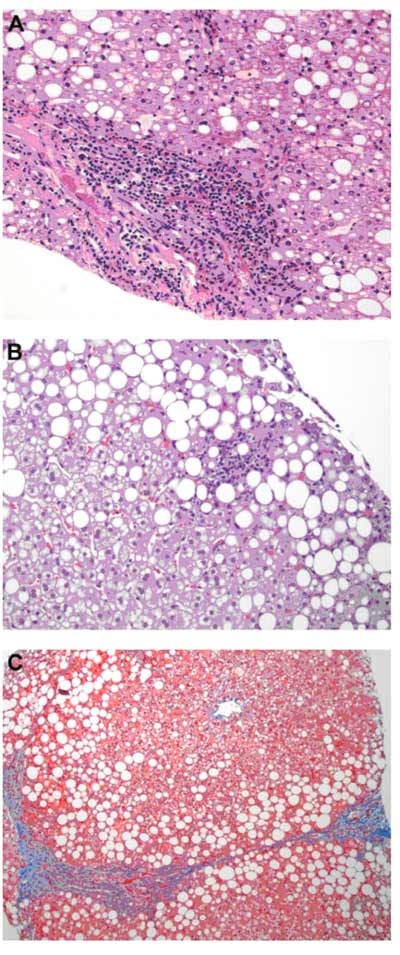Non-Alcoholic Fatty Liver Disease – An Emerging Problem with Childhood Obesity
by Thomas M Attard
Amongst the more clinically serious consequences of the global epidemic in obesity in children is the emergence of non-alcoholic steato-hepatitis (NASH), alternatively known as non-alcoholic fatty liver disease (NAFLD). The incidence of elevated transaminases (ALT, AST) in diverse obese adolescent populations is close to 3%.1,2 In adults, approximately 30% of obese individuals with elevated transaminases have steatohepatitis and almost half of these individuals will have progressive liver disease. The corresponding incidence of fatty liver in children is unclear; Moran and coworkers first demonstrated the occurrence of severe hepatitis and fibrosis in three obese children with transaminasemia in 1983.3 This was followed by several other reports defining the incidence of severe fibrosis or cirrhosis in one-third of children undergoing liver biopsy for the same indication.
The disease process evolves from an initial period of increased fat in the liver without inflammation (steatosis) to fat accumulation with inflammation – hepatitis (steatohepatitis). NAFLD represents a complex metabolic disorder strongly associated with visceral adiposity and insulin resistance. It is thought that the disease progresses from an initial fat accumulation in the liver which sets the stage for a ‘second hit’ including oxidative stress that induces persistent liver injury, leading to fibrosis and cirrhosis.4 There are clear pointers toward a genetic predisposition to the development of NAFLD, including mutations in the PNPLA3 gene that induces hepatic fat accumulation and inflammation.5 In fact several epidemiologic studies have shown that familial aggregation of NAFLD is independent of BMI.6. There are also ethnic differences that point toward genetic, but also potentially dietary factors; the disease being the least prevalent in Afro-Americans despite the high incidence of insulin resistance in this group. Since the disease is less prevalent in females than males, estrogen is considered to have a protective effect.
The critical difficulty in defining the prevalence of NAFLD in children has been the inadequacy of diagnostic criteria in obese children and adolescents. The degree of transaminasemia neither distinguishes between steatosis and steatohepatitis, nor does it predict the severity of liver injury. Imaging modalities including hepatic ultrasound and magnetic resonance have limited applicability in determining the presence and severity of fibrosis. To date, liver biopsy remains the only way to determine whether a child has steatosis, steatohepatitis or fibrosis.
Obese children can have alternative causes for transaminasemia and chronic liver disease. It is important to consider these other etiologies including chronic viral hepatitis, Wilson’s disease and autoimmune hepatitis (AIH). In particular, hypothyroidism and Cushing’s Syndrome are associated with adiposity and can be associated with abnormal liver function tests. Obese children with persistently elevated serum transaminases, particularly those whose elevations remain over twice normal, require liver biopsy to exclude other causes of liver pathology, and to determine the presence and severity of fibrosis or cirrhosis in those with steatohepatitis.
Children with NAFLD are more likely to have obstructive sleep apnea and acanthosis nigricans.7 Compared to BMI-matched controls, children with NAFLD are likely to have components of the metabolic syndrome including dyslipidemia and hypertension. In fact, hepatic steatosis itself appears to have an adverse impact on cardiovascular outcomes.8
The outcome of childhood NAFLD is unknown. There is certainly an increased mortality from cardiovascular disease followed by cancer and liver disease, in part related to the association with the metabolic syndrome. Children with NAFLD have a 13-fold increased risk of death or needing a liver transplant compared to an age and sex-matched population.9. Diagnostic modalities are being studied to determine the subgroup of patients at risk of progression to liver fibrosis and cirrhosis.
Treatment options in pediatric NAFLD include diet and exercise, Vitamin E, ursodiol and the oral hypoglycemic agent metformin. Given the relationship with obesity, targeting pediatric obesity should help in decreasing the burden of pediatric NAFLD. The impact of weight loss in decreasing steatohepatitis in children is however, unknown. Studies suggest that a 5% weight loss is associated with significant histologic improvement.10 It is important that dietary intervention in children aimed toward weight loss includes consultation and monitoring by a registered dietician and includes regular aerobic exercise progressing in difficulty as fitness allows.11
Vitamin E (alpha tocopherol), by virtue of its anti-oxidant properties has been proposed as a potential treatment for NAFLD and has been shown to decrease serum ALT in an open label study in obese children.12 Similar studies are underway for ascorbic acid in addition to vitamin E. Some studies have suggested improvement in transaminases with ursodiol alone or in combination with Vitamin E although at this time, routine use of ursodiol for pediatric NAFLD does not appear justified.13 Metformin is the only oral hypoglycaemic agent extensively used in childhood NAFLD. Adult studies suggest it improves NAFLD by inducing weight loss. Preliminary studies suggest that, at a dose of 500 mg twice daily, it is effective in improving transaminasemia and improving radiologic markers of NAFLD.
Obesity is also a recognized risk factor in other hepatobiliary disorders in children and needs to be borne in mind. Overweight, especially female adolescents are more likely to develop gallstones, and concomitant hypertriglyceridemia is a recognized risk factor in pediatric pancreatitis.
In conclusion, the obese child and adolescent is at risk of liver disorders most notably the development of nonalcoholic fatty liver disease. Strategies geared toward prevention including education on exercise and diet seem to hold the greatest promise to improve outcomes as trials are in progress to define the potential scope of pharmacotherapy in this disease.


